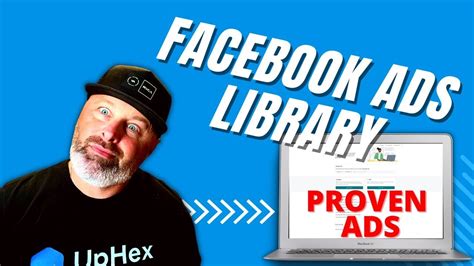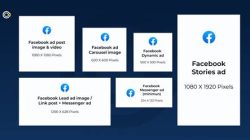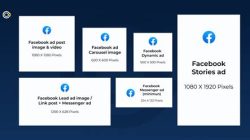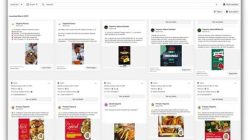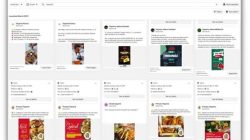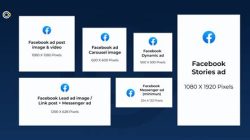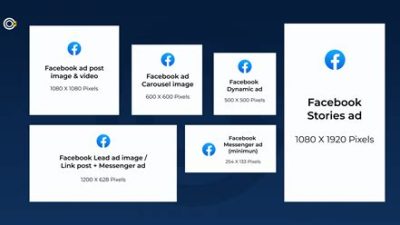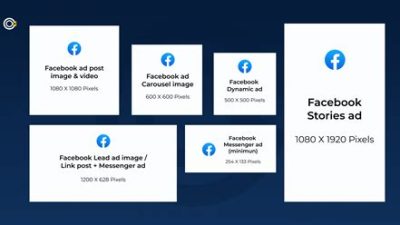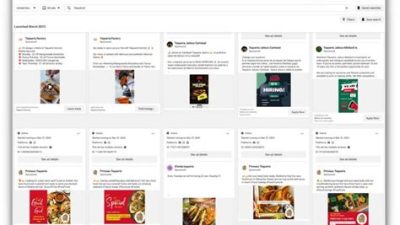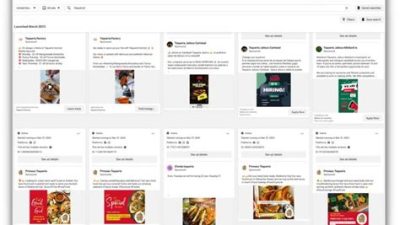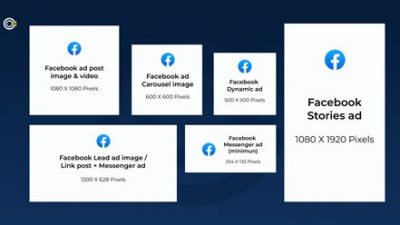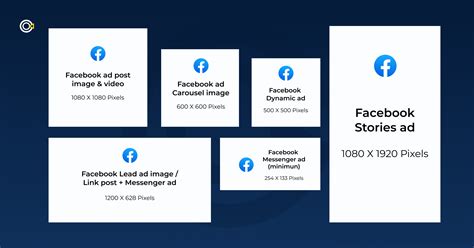
When it comes to advertising on Facebook, getting the right ad size is super important for making your posts stand out. With so many different formats available, it can be a bit confusing to figure out what dimensions work best for your specific goals. Whether you’re promoting a product or trying to build your brand, knowing the optimal sizes for your Facebook ads can be the difference between scrolling past and making a click. Let’s dive into the essentials of Facebook ad sizes and why they matter.
Understanding Facebook Ad Formats
When diving into Facebook ads, it’s crucial to understand the different formats available and how they align with your marketing goals. Facebook offers a variety of ad formats, including image ads, video ads, carousel ads, and collection ads, each designed to capture attention in different ways. Image ads are straightforward and quick to create, making them a go-to for many advertisers. Typically, these ads perform best when they contain high-quality visuals that resonate with the target audience. On the other hand, video ads can be a powerful tool for storytelling and engagement, allowing brands to convey messages with depth and personality. Carousel ads offer a unique advantage as they let businesses showcase multiple images or videos in a single ad and allow users to swipe through them. This format is particularly effective for highlighting multiple products or features, keeping the content dynamic and engaging. Lastly, collection ads combine video and image elements, providing an immersive shopping experience right within the Facebook platform. As these formats cater to various marketing strategies, understanding their nuances can set the stage for a successful campaign.
Optimal Image and Video Sizes
When creating Facebook ads, one of the most critical components to consider is the size and aspect ratio of the images and videos you will be using. For singular image ads, the recommended dimensions are 1200 x 628 pixels, ensuring that your images maintain clarity across devices. Such sizes prevent your visuals from being cropped awkwardly, which can detract from the message you’re trying to convey. Video ads, meanwhile, often perform better when they are uploaded in a 1:1 (square) format or 16:9 (horizontal) aspect ratio, with a minimum resolution of 720p for quality. It’s worth noting that videos should ideally be 15 seconds long or less to maintain audience attention—a vital aspect considering that many users scroll quickly through their feeds. Additionally, Facebook allows for different sizes across its various ad placements, such as feeds, stories, or marketplaces. It’s essential to adapt your visual content for each placement for optimal results, ensuring that whether on a mobile or desktop, your ads look great and drive engagement.
Text Guidelines for Facebook Ads
Alongside images and videos, the text used in Facebook ads plays a pivotal role in how effectively they can communicate your message. While there’s no strict limit on the amount of text you can use, Facebook recommends keeping it concise and to the point. Clear headlines and compelling captions can make a huge difference in click-through rates. Ideally, if you’re using the headline feature, it should be around 40 characters long, while body text should remain beneath 125 characters. Often, a strong call to action is necessary to compel users into clicking on your ad. However, keep in mind that Facebook penalizes ads with too much text overlay on images. The classic rule of thumb is to use less than 20% of the image space for text; Facebook’s Text Overlay Tool can help you check this before launching your campaign. Ultimately, combining visual appeal with succinct, engaging text helps create ads that resonate with users and entice them to learn more.
Mobile vs. Desktop Ad Sizes
With the vast majority of users accessing Facebook via mobile devices, it’s vital to tailor ad sizes specifically for mobile viewers. The mobile user interface differs from desktop, and so do the dimensions for ads. For mobile feed ads, dimensions like 1080 x 1080 pixels make for an eye-catching experience on small screens. On a desktop, ads can be slightly wider and benefit from dimensions like 1200 x 628 pixels to utilize the extra screen space. Additionally, aspects such as text size and button placements should be optimized for touch, ensuring that clickable elements are large enough for easy use on mobile devices. Moreover, considering that more people are watching videos on-the-go, mobile-friendly video formats—such as vertical videos—can enhance engagement. Adapting your strategy to cater to mobile first is essential in today’s advertising landscape, ensuring all audiences are effectively reached regardless of how they access their social media.
Testing and Analyzing Ad Performance
Once you’ve crafted compelling Facebook ads with the right formats and sizes, the next step is to launch and monitor their performance. Regularly testing your ads is a critical factor in identifying what works best for your audience. You can conduct A/B testing by running two versions of an ad with slight variations—such as different images, text, or calls to action—to determine which performs better. Facebook’s Ads Manager provides in-depth analytics, helping you track metrics such as reach, impressions, and click-through rates. Utilizing these insights allows you to refine your campaigns over time. For example, if you notice that one image resonates better than another, you can allocate more of your budget toward that successful ad. Similarly, looking at engagement metrics can inform not just whether to adjust ad types or sizes but also about the audience you’re targeting. Over time, as you adapt to data-driven insights, you’ll improve your Facebook advertising effectiveness, leading to higher returns on investment.
Understanding Facebook Ad Sizes: A Comprehensive Guide
1. Importance of Choosing the Right Ad Size
When it comes to Facebook ads, selecting the appropriate ad size plays a crucial role in achieving your marketing objectives. Each ad format serves a different purpose, and using the right size can significantly impact how your audience interacts with your content. For brands looking to enhance their visibility on social media, being mindful of the ad dimensions ensures that your messaging gets the attention it deserves.
Firstly, ads that fit the designated space seamlessly tend to capture user attention more effectively. A visually appealing ad not only attracts clicks but also encourages users to engage with your brand. On the flip side, improperly sized ads can lead to cropping or awkward framing, detracting from the overall user experience. This mismatch can lead to lost impressions and even higher ad fatigue as your audience scrolls past poorly displayed content.
Moreover, different ad placements on Facebook (like the News Feed, Stories, or Marketplace) require specific sizes to maintain an optimal display. By understanding these dimensions, you can tailor your advertising strategies to fit various placements, optimizing your reach and engagement. A well-designed ad that uses the correct size for its placement can result in higher click-through rates—a key metric in assessing your ad’s performance. And in the competitive landscape of social media advertising, every percentage point matters.
| Ad Placement | Recommended Size |
|---|---|
| Feed Center | 1200 x 628 pixels |
| Story Ads | 1080 x 1920 pixels |
| Carousel Ads | 1080 x 1080 pixels |
2. Optimal Dimensions for Different Ad Formats
Facebook offers several ad formats, each requiring specific dimensions to ensure effective visibility. Understanding these dimensions is essential for crafting compelling ads that grab attention and drive engagement. Here’s a breakdown of the most widely used Facebook ad formats and their recommended sizes:
First, we have the single image ad, which is the most straightforward option. For this, the ideal size is 1200 x 628 pixels. This rectangular format works well on both desktop and mobile platforms, providing a significant surface area for your visual content.
Next is the video ad, with recommended dimensions similar to the image ad. However, it’s worth noting that video length and aspect ratio can also influence user engagement. Facebook suggests a ratio of 16:9 to 1:1 for video ads, giving you flexibility based on your creative assets.
For brands looking to showcase multiple products or stories, carousel ads allow you to include up to 10 images or videos in a single ad unit. Each card in the carousel should ideally be sized at 1080 x 1080 pixels, allowing for a square format that portrays products appealingly.
| Ad Type | Recommended Size |
|---|---|
| Single Image | 1200 x 628 pixels |
| Video | 1280 x 720 pixels |
| Carousel | 1080 x 1080 pixels |
3. Image and Video Resolution Best Practices
The resolution of your images and videos is critical in determining how visually appealing your ads will be. High-quality images create a professional impression, drawing in potential customers and promoting higher engagement rates. It’s recommended to upload images that are at least 1080 pixels wide to avoid pixelation and ensure crisp clarity on both desktop and mobile devices.
Smaller images may look fine on some screens, but they can become blurry or stretched on larger devices, diminishing your brand’s credibility. Videos, too, should maintain a resolution of at least 720p. The clarity of your video content is essential, particularly for storytelling. Users are less likely to engage with low-quality video, leading to a negative perception of your brand.
In addition, be mindful of the file formats you use. For images, JPEG or PNG formats are typically recommended, as these strike a good balance between quality and file size. For videos, MP4 or MOV formats are preferred, allowing for smooth playback and compatibility across devices.
| Asset Type | Minimum Resolution |
|---|---|
| Images | 1080 pixels wide |
| Videos | 720p resolution |
4. Mobile vs. Desktop: Ad Size Considerations
As mobile usage continues to rise, understanding the differences between mobile and desktop ad sizes is essential for any digital marketer. Ads that appear on mobile devices often require different dimensions than their desktop counterparts. Ignoring these subtleties can lead to missed opportunities in reaching your audience effectively.
For starters, mobile ads generally favor vertical and square formats as mobile phones are predominantly held in portrait mode. This orientation provides a more immersive experience for users. For instance, Facebook’s Story Ads, which are designed for quick viewing on mobile screens, should ideally measure 1080 x 1920 pixels to fit perfectly within users’ viewing frames.
Conversely, desktop ads can stretch more horizontally, making them ideal for landscape visuals that tell a broader story. It’s essential to create variations of your ads tailored for specific devices, enhancing user experience and engagement rates. Additionally, testing different formats on various platforms can provide insight into which adaptations yield the best performance and user interaction.
| Device | Recommended Ad Sizes |
|---|---|
| Mobile | 1080 x 1920 pixels (Stories), 1200 x 628 pixels (Feed) |
| Desktop | 1200 x 628 pixels (Feed) |
5. Frequently Asked Questions About Facebook Ad Sizes
What is the recommended size for Facebook feed images?
The recommended size for Facebook feed images is 1200 x 628 pixels. This size ensures that your images are displayed correctly across both desktop and mobile platforms.
Are there different sizes for Facebook Stories ads?
Yes! The ideal dimensions for Facebook Stories ads are 1080 x 1920 pixels, which are designed for vertical viewing on mobile devices.
Can I use the same image for different ad formats?
While you can use the same image, it’s best to adjust its size to fit the requirements of each ad format to avoid distortion or cropping.
What format should my video ad be in?
Your video ad should ideally be in MP4 or MOV format to ensure high quality and compatibility on the platform.
How long can my video ad be?
Facebook recommends keeping your video ads under 15 seconds to hold viewer attention effectively, though ads can be longer if necessary.
Are there any restrictions on ad text?
Facebook prefers ads to have minimal text on the image. Generally, ads with less than 20% text in the image get better reach and engagement.
How can I ensure my ads are mobile-friendly?
To ensure mobile-friendliness, use images and sizes optimized for mobile screens, such as 1080 x 1920 pixels for Stories and 1200 x 628 pixels for feed ads.
Do I need different sizes for desktop ads?
Yes, while some sizes overlap, each platform may require variations to optimize display. Desktop ads often have wider dimensions that capitalize on larger screen real estate.
What’s the best aspect ratio to use for image ads?
The recommended aspect ratio for Facebook image ads is 1.91:1 for feed images and 9:16 for Stories, optimizing visual impact across placements.
How often should I update my ad creatives?
It’s recommended to refresh your ad creatives every 1-2 weeks to prevent ad fatigue and maintain user interest.
Should I include a call-to-action (CTA) in my ads?
Definitely! Including a clear CTA in your ads encourages users to take specific actions, such as visiting your website or signing up for a newsletter.
Can I run ads without images or videos?
While you can create ad campaigns with just text, visual content has proven to be significantly more engaging and should be prioritized for better performance.
What are the penalties for using incorrect ad sizes?
Ads that do not meet the required sizes may be cropped, leading to poor visual appeal and potentially reduced engagement and reach.
Is there a size limit for uploaded images?
Yes, Facebook limits uploaded images to a 30MB file size, so make sure to optimize images for web to stay under that limit.
Are there any tools available to help determine ad sizes?
Yes, Facebook’s Ads Manager provides tools and guidelines to help marketers choose the correct ad sizes and formats for different campaigns.
What are some tips for creating effective Facebook ads?
Focus on high-quality visuals, concise messaging, clear CTAs, and ensure alignment with your brand’s tone. Testing different formats can also optimize effectiveness.
Thanks for Stopping By!
We really appreciate you taking the time to read our guide on Facebook ads sizes! We hope you found it helpful and now feel ready to create some eye-catching ads that drive results. Don’t forget to bookmark this page and check back later for more tips and tricks on all things digital marketing. Until next time, happy advertising!
